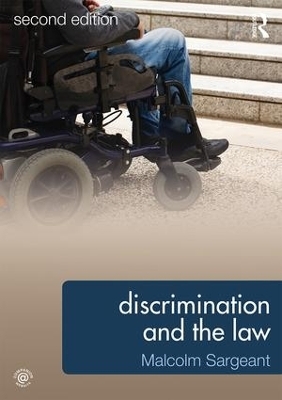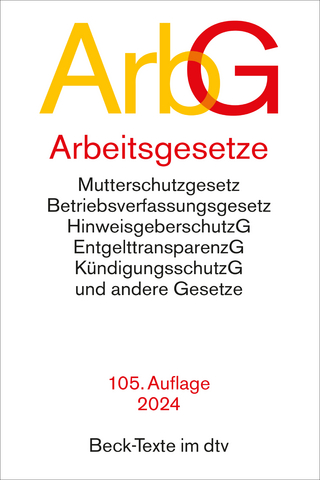
Discrimination and the Law 2e
Routledge (Verlag)
978-1-138-74507-0 (ISBN)
Discrimination and the Law provides an exploration and evaluation of discrimination law, focusing primarily on discrimination in employment. Introducing readers to the concepts of equality and the historical origins of discrimination law, Malcolm Sargeant explores the wider political, social and economic contexts through which discrimination law has evolved. The second edition has been thoroughly updated and includes a new chapter considering discrimination against trade unionists, discrimination against ‘non-standard’ workers as well as the public sector equality duty.
The book begins with an examination of what is meant by such concepts as equality and discrimination followed by an analysis of the Equality Act 2010 and the impact of EU and international law. All the protected characteristics contained in the Equality Act 2010 are critically considered (age, disability, gender reassignment, marriage and civil partnership, pregnancy and maternity, race, religion or belief, sex, sexual orientation). Issues not covered by the legislation such as those relating to multiple discrimination and caste discrimination are also analysed.
Important cases from the UK courts as well as international courts are considered. The book also contains an appendix with the most relevant parts of the 2010 Act. Important cases are highlighted in the text and some reflections as the basis for further discussion are included at the end of each chapter.
This is an essential introduction to the wide-ranging law relating to discrimination in the UK for law, HRM and business students.
Malcolm Sargeant is Professor of Labour Law at Middlesex University and teaches discrimination law at both undergraduate and postgraduate levels. He is an academic fellow of the CIPD and co-author of several student text books on employment law as well as being the author and editor of other books on aspects of discrimination and employment law.
Detailed Contents
Preface x
List of tables xi
Glossary of acronyms xii
Table of cases xiii
Table of legislation xvii
1 Equality 1
1.1 Purpose 2
1.2 How fair is Britain? 2
1.3 Equality 3
1.4 Stereotyping 6
1.5 Does discrimination still take place? 7
1.6 The grounds for discrimination 9
1.7 Multiple discrimination 10
1.8 Discrimination outside employment 12
1.9 Reflections 14
2 European perspectives 16
2.1 Brexit 17
2.2 The European Union 17
2.3 The Equality Directives 18
2.4 Facilities, goods and services 25
2.5 Human rights 26
2.6 Reflections 28
3 The Equality Act 2010 30
3.1 Introduction 31
3.2 The protected characteristics 31
3.3 Prohibited conduct 32
3.4 Burden of proof 39
3.5 Equality of terms 41
3.6 Remedies 41
3.7 Liability of employers and employees 42
3.8 Relationships that have come to an end 42
3.9 Aiding contraventions 43
3.10 Contracts 43
3.11 The Enterprise and Regulatory Reform Act 2013 43
3.12 Reflections 44
4 Age and ageism 46
4.1 Introduction 47
4.2 Population ageing 48
4.3 Attitudes to age 49
4.4 The Framework Directive 50
4.5 Young workers 52
4.6 Unlawful actions 53
4.7 Direct and indirect discrimination 54
4.8 The Equality Act 2010 56
4.9 Reflections 58
5 Disability 60
5.1 Introduction 61
5.2 The United Nations Convention 63
5.3 The Equality Act 2010 64
5.4 The meaning of disability 64
5.5 Unfavourable treatment 70
5.6 Duty to make adjustments 70
5.7 Positive action 72
5.8 Recruitment 72
5.9 Reflections 73
6 Pregnancy and maternity 75
6.1 Introduction 76
6.2 Discrimination 77
6.3 The Pregnant Workers Directive 79
6.4 Protection in the United Kingdom 81
6.5 The Maternity and Parental Leave etc. Regulations 1999 81
6.6 Employment rights 82
6.7 Protection from detriment and dismissal 84
6.8 Return to work 86
6.9 Shared parental leave 86
6.10 Reflections 87
7 Race, colour, ethnicity and migrant workers 89
7.1 Introduction 90
7.2 The Race Directive 91
7.3 The Equality Act 2010 92
7.4 Migrant workers 96
7.5 Reflections 103
8 Religion or belief 105
8.1 Introduction 106
8.2 Religion 106
8.3 Belief 107
8.4 The Equality Act 2010 108
8.5 Occupational requirements relating to organised religion and belief 110
8.6 Manifestation of religious belief 111
8.7 Sexual orientation 112
8.8 The European Convention on Human Rights 113
8.9 The European Court of Human Rights 115
8.10 Reflections 117
9 Sex equality 119
9.1 Introduction 120
9.2 Women and men 120
9.3 The European Union 122
9.4 The Equality Act 2010 123
9.5 Marriage or civil partnership 124
9.6 Older women 125
9.7 Equality of terms 127
9.8 Women on boards 131
9.9 Gender pay gap information and discussions about pay 132
9.10 Reflections 133
10 Sexual orientation and gender reassignment 136
10.1 Introduction 137
10.2 Sexual orientation 137
10.3 LGBT 137
10.4 Gender reassignment 140
10.5 Marriage or civil partnership 142
10.6 Reflections 143
11 Discrimination in the workplace 145
11.1 Trade union membership and activities 146
11.2 Non-standard working 148
11.3 Public sector equality duty 153
11.4 How to prevent discrimination in the workplace 154
11.5 Reflections 156
Appendix – Equality Act 2010 Part 2 158
Bibliography 168
Index 172
| Erscheinungsdatum | 30.01.2018 |
|---|---|
| Zusatzinfo | 13 Tables, black and white |
| Verlagsort | London |
| Sprache | englisch |
| Maße | 174 x 246 mm |
| Gewicht | 342 g |
| Themenwelt | Recht / Steuern ► Allgemeines / Lexika |
| Recht / Steuern ► Arbeits- / Sozialrecht ► Arbeitsrecht | |
| Recht / Steuern ► EU / Internationales Recht | |
| Wirtschaft ► Betriebswirtschaft / Management ► Personalwesen | |
| Wirtschaft ► Volkswirtschaftslehre | |
| ISBN-10 | 1-138-74507-3 / 1138745073 |
| ISBN-13 | 978-1-138-74507-0 / 9781138745070 |
| Zustand | Neuware |
| Haben Sie eine Frage zum Produkt? |
aus dem Bereich


